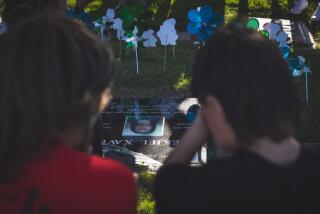The Terrible Price of Pushing the Envelope
It was just a mistake, his friends keep saying, as Marcus Christian Lellan sits in a Los Angeles County jail cell, charged with four counts of vehicular manslaughter.
They wonder if the high school senior should have to pay with a prison term for a momentary lapse in judgment . . . a mistake that cost three of his friends and another man their lives.
Lellan, 18, was speeding along a road in the Santa Clarita Valley when he veered to the right to pass a car and lost control of his Acura, police said. He careened through the center median at 90 mph, hit a divider that sent his car airborne and flipped it over in midair. His car sheared off the top of an oncoming Mustang.
Lellan and his front-seat passenger, Daniel Weber, 16, were unhurt. The Mustang’s driver, Rodney Adams, 45, and all three of Lellan’s back-seat passengers were killed.
Timothy Renolds, 17, died trapped in the back seat. His 15-year-old brother Daniel, and their friend Nick Ianozzi, 16, died when they were thrown from the car.
*
For days after the Feb. 17 crash, hundreds of teenagers gathered at the accident site on Soledad Canyon Road.
They mourned their dead friends . . . and, in the same breath, complained about the possibility that the young man whose act ended their lives might now have to spend several years behind bars.
“It’s not like he went out and said, ‘I want to kill my friends today,’ ” Canyon High classmate Tina Bailey told reporters the day after the crash. “Everybody makes mistakes; he’s not a bad person.”
It has not yet sunk in, the cold, hard truth that a mistake can also be a crime; that guilt cannot be obscured by innocent intentions; that the burden of blame must sometimes fall on shoulders already slumped in grief and shame.
The tale of the teenagers’ tragedy sent a chill through a group of Pasadena middle-schoolers I addressed last week.
At 12 and 13, they are already coveting the freedom a driver’s license conveys. Their hearts ache for the dead, but also for Lellan. They can put themselves in his shoes . . . if not in the jail garb that he now wears.
“It doesn’t seem fair that he should have to go to prison,” one girl said. “I mean, you make one mistake . . . and it’s over?”
In fact, Lellan had been ticketed by police twice in the last four months for speeding along that same road.
*
But teenagers today are barraged by threats of dire consequences from well-meaning adults with long lists of rules: If you have sex, you can die of AIDS. If you hang with the wrong crowd, you could wind up dead in a drive-by shooting. If you drink and drive, you could lose your license, or your life.
And, just as we did at their age, they tend to think they can outsmart trouble . . . that tragedy only visits those who are not so young or clever or privileged.
I listen as these Eliot Middle Schoolers cast about for explanations, like junior tort attorneys, doling out blame in percentage points.
“Maybe the [teenager] driving was drinking, or on drugs?” one young fellow offers, as if that might protect the innocent and make the guilty easier to blame.
Police said they do not believe Lellan had been drinking but are awaiting results of alcohol and drug tests.
Another assigns fault to the dead themselves: “Those guys in the back seat, they should have been wearing seat belts.”
At the heart of their struggle is the notion of responsibility. How do you calibrate the wheels of justice to calculate a punishment that registers both earned guilt and earnest pain?
“Is it more of a crime, or more of a tragedy?” asks James Blatt, the attorney hired by Lellan’s family to represent their son.
“Kids look at this case and relate to it on an emotional view--’It could have been me behind the wheel. . . . It’s punishment enough that he has to live with the painful loss of his friends.’
“But as adults, as parents, we look at it as, ‘What if it was my child [that died].’ As adults, you feel the anger, the rage, the great sense of loss . . . the notion that somebody has to pay.
“They are both valid, but two very different perspectives.”
*
Then there is that third perspective . . . the one that reflects the interests of society.
There is logic, after all, in the rules we make and pass along to protect our children as they step beyond the bounds of our control.
There’s a reason for speed limits, for the rule that you must wear seat belts in cars, for our state law that forbids new teenage drivers from riding around with their friends in the car. And the penalty is not always a ticket, a day of traffic school, a lecture from an irate mom or dad.
Live on the edge if you wish . . . push limits, break rules, risk consequences. But never forget what hangs in the balance: Lives lost, ruined, forever changed.
Sandy Banks’ column is published on Sundays and Tuesdays. Her e-mail address is sandy.banks@latimes.com.
More to Read
Sign up for Essential California
The most important California stories and recommendations in your inbox every morning.
You may occasionally receive promotional content from the Los Angeles Times.










